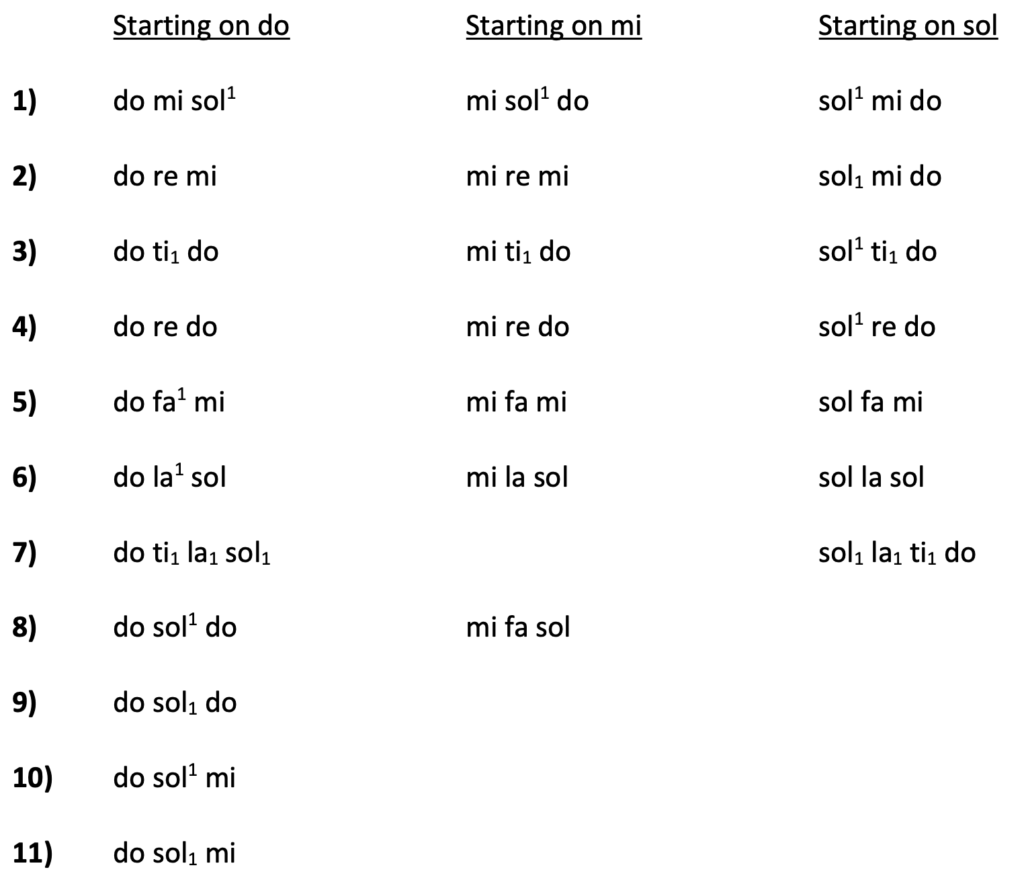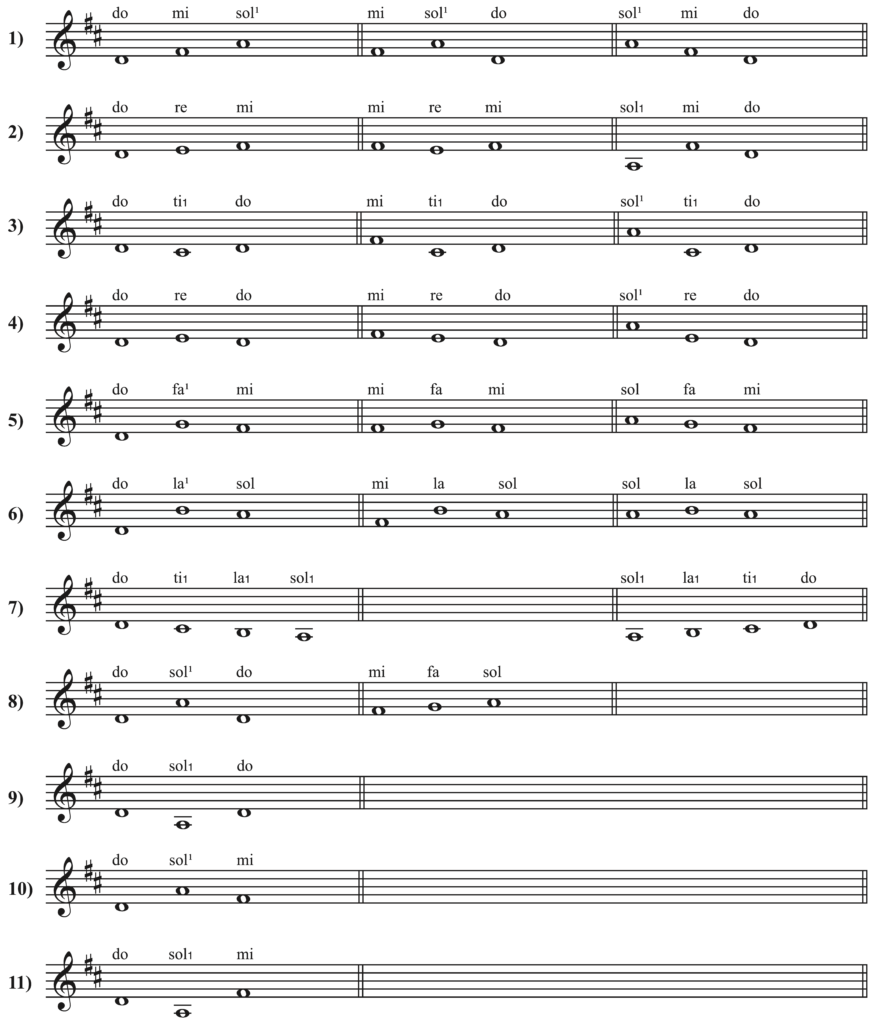Main Body
4 Major key signatures
Learning goals for Chapter 4
In this chapter, we will learn:
- What major key signatures are
- How to construct major key signatures
- How to identify major key signatures
- How to sing three- and four-note pitch patterns in major keys, focused on diatonic anchors (do, mi, and sol)
Major key signatures
When pieces of music use a scale for an extended period of time, it would become too cumbersome to continually write out every accidental (sharp or flat) every time it appears in the music. Instead, it is customary to use a , a symbol that summarizes all of the flats or sharps used in a particular key, which is placed at the beginning of every system (staff) in a composition. The placement and order of key signatures are standardized and fixed. Example 4‑1 shows the order and placement for the sharps or flats in a key signature employing sharps and those using flats in treble and bass clefs.
The order of sharps and flats follows a predictable pattern, called the , which should be memorized. The order of sharps F C G D A E B, and the order of flats reverses this pattern: B E A D G C F. The circle of fifths may also be shown in visual form, as in Figure 4‑1.
Beginning at the top of the circle with C major (no sharps or flats), one sharp is added at each point going clockwise around the circle: G major (one sharp, F![]() ), D major (two sharps, F
), D major (two sharps, F![]() and C
and C![]() ), A major (three sharps, F
), A major (three sharps, F![]() , C
, C![]() , and G
, and G![]() ), E major (four sharps, F
), E major (four sharps, F![]() , C
, C![]() , G
, G![]() , and D
, and D![]() ), B major (five sharps, F
), B major (five sharps, F![]() , C
, C![]() , G
, G![]() , D
, D![]() , and A
, and A![]() ), F
), F![]() major (six sharps, F
major (six sharps, F![]() , C
, C![]() , G
, G![]() , D
, D![]() , A
, A![]() , and E
, and E![]() ), and finally C
), and finally C![]() major (all seven sharps).
major (all seven sharps).
Again starting with C major at the top, one flat is added at each point going counterclockwise around the circle: F major (one flat, B![]() ), B
), B![]() major (two flats, B
major (two flats, B![]() and E
and E![]() ), E
), E![]() major (three flats, B
major (three flats, B![]() , E
, E![]() , and A
, and A![]() ), A
), A![]() major (four flats, B
major (four flats, B![]() , E
, E![]() , A
, A![]() , and D
, and D![]() ), D
), D![]() major (five flats, B
major (five flats, B![]() , E
, E![]() , A
, A![]() , D
, D![]() , and G
, and G![]() ), G
), G![]() major (six flats, B
major (six flats, B![]() , E
, E![]() , A
, A![]() , D
, D![]() , G
, G![]() , and C
, and C![]() ), and finally C
), and finally C![]() major (all seven flats).
major (all seven flats).
Notice that there are three pairs of keys at the bottom of the circle that are , meaning that they sound the same, but are spelled differently. These are D![]() and C
and C![]() major, G
major, G![]() and F
and F![]() major, and C
major, and C![]() and B major.
and B major.
Here are some tricks for identifying the major key signatures:
For major keys with sharps, the last sharp is always the of the key. For example, E major has four sharps, and the last sharp is D![]() , the leading tone in the E major scale. If you forget what the leading tone is in a particular key, you can easily find it by identifying the note that is a diatonic half step below tonic.
, the leading tone in the E major scale. If you forget what the leading tone is in a particular key, you can easily find it by identifying the note that is a diatonic half step below tonic.
For major keys with flats, the second-to-last flat is the tonic of the key. For example, A![]() major has four flats (B
major has four flats (B![]() , E
, E![]() , A
, A![]() , and D
, and D![]() ), and the second-to-last flat is A
), and the second-to-last flat is A![]() , its tonic.
, its tonic.
Video: T07 Major key signatures (4:15)
This video presents tips and tricks for learning major key signatures.
Slides: Are you wondering why we have key signatures? Check out this slideshow.
Access the audio for examples featured in the slideshow here: Spotify playlist for Why key signatures?
EXERCISE 4-1 Major scales and key signatures
PART A. On the staff provided or on a separate sheet of staff paper, write the notes for each major scale. Place accidentals on the appropriate line or space immediately preceding the notes they modify. Do not use key signatures. Finally, bracket the location of all half steps. The first is done for you.

PART B. Provide key signatures for the specified keys.

Want more practice identifying and constructing major key signatures? Try these drills:
Practice identifying major key signatures (teoria)
Practice identifying major key signatures (musictheory.net)
Practice constructing major key signatures (teoria)
Practice constructing major key signatures (musictheory.net)
Pitch patterns in major keys
Composer and theorist Guido di Arezzo (ca. 990–1050) wrote that solmization, or solfege, “will be of great use to you either in the competent singing of an unknown melody as soon as you see it written down, or in the accurate transcription of an unwritten melody immediately upon hearing it.”[1]
To this end, we will practice singing, playing, and aurally identifying the pitch patterns in Figure 4‑2. In cases that may seem ambiguous, superscripts (1) indicate a pitch in the higher octave (above the previous note), and subscripts (1) indicate a pitch in the lower octave (below the previous note). These patterns are also shown in staff notation in Example 4‑2. Although they appear in D major in this example, they should be practiced in other major keys as well.
Figure 4‑2. Pitch patterns in major
Video: S02 Pitch patterns in major keys (5:50)
This interactive video presents each of the major pitch patterns, sung and with hand signs. Practice singing the pitch patterns and using the appropriate hand signs with the video.
Supplemental resources for Chapter 4
- From "Epistola de ignoto cantu," translated in Source Readings in Music History, ed. Oliver Strunk, rev. ed. Leo Treitler (New York: W. W. Norton, 1998), 217–18. ↵
symbol that summarizes all of the flats or sharps used in a particular key, which is placed at the beginning of every system in Western musical notation
a pattern that shows the system of key signatures in Western tonal music, whereby moving clockwise along the circle each key signature gains one sharp and moving counter-clockwise each key signature gains one flat; tonics of each adjacent key along the circle are related by P5; also refers to a harmonic sequence that features root motion by fifth
term describing the relationship of notes or chords that sound the same, but are spelled differently
scale degree 7 in any major, harmonic minor, or ascending melodic minor scale; this scale degree is always a half step below tonic




